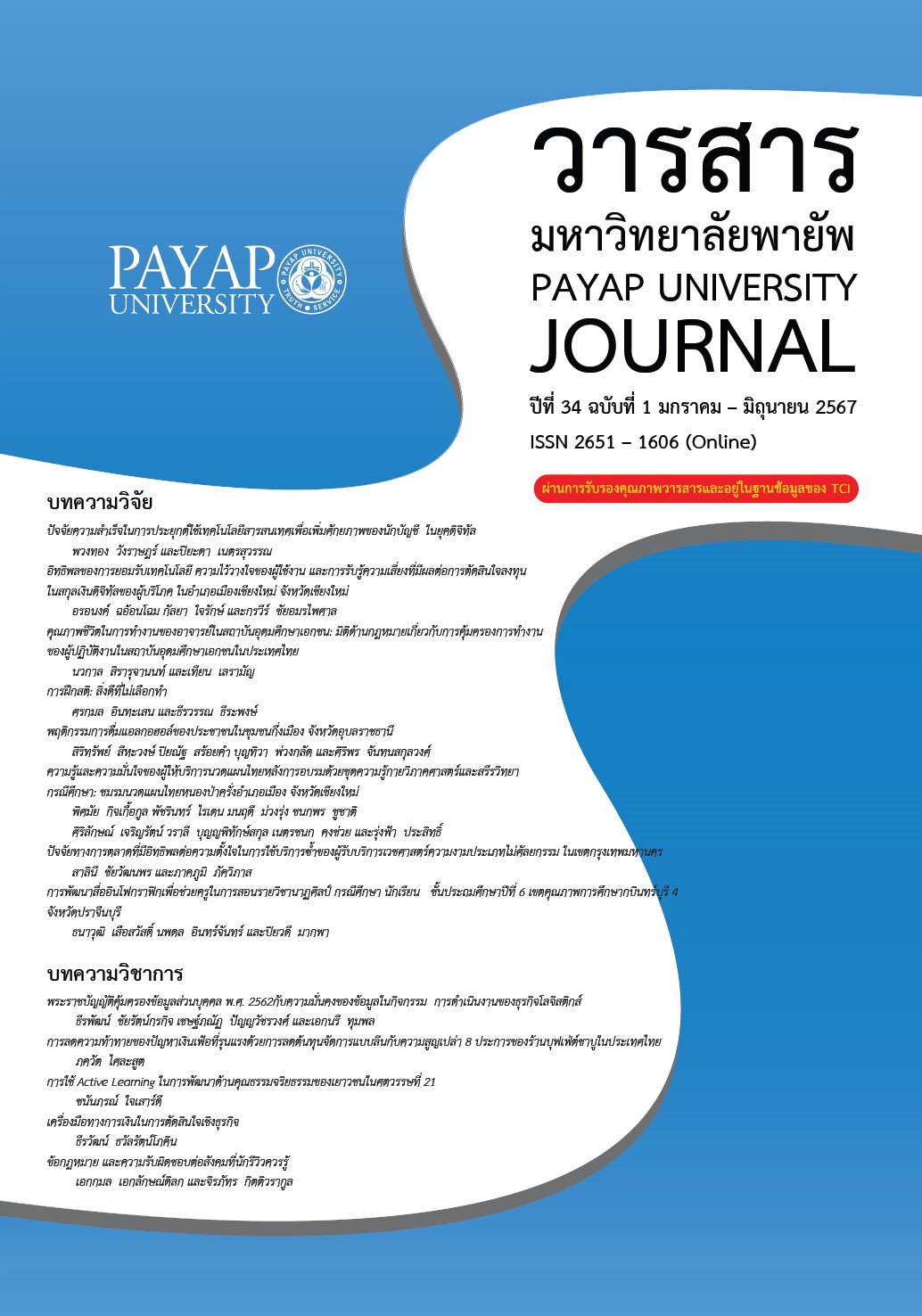ความรู้และความมั่นใจของผู้ให้บริการนวดแผนไทยหลังการอบรม ด้วยชุดความรู้กายวิภาคศาสตร์และสรีรวิทยา กรณีศึกษา: ชมรมนวดแผนไทย หนองป่าครั่ง อำเภอเมือง จังหวัดเชียงใหม่
Main Article Content
บทคัดย่อ
การวิจัยครั้งนี้เป็นการวิจัยแบบกลุ่มเดียว วัดผลก่อนและหลังการอบรมชุดความรู้ด้าน กายวิภาคศาสตร์และสรีรวิทยา มีวัตถุประสงค์เพื่อเปรียบเทียบความรู้และความมั่นใจในการนำความรู้ด้านกายวิภาคศาสตร์และสรีรวิทยาประยุกต์ใช้สู่การให้บริการนวดแผนไทย กลุ่มตัวอย่าง คือ ผู้ให้บริการนวดแผนไทยชมรมนวดแผนไทยหนองป่าครั่ง อำเภอเมือง จังหวัดเชียงใหม่ จำนวน 22 ราย เก็บรวบรวมข้อมูลโดยใช้แบบทดสอบวัดความรู้ และแบบวัดความมั่นใจในการนำความรู้ด้าน กายวิภาคศาสตร์และสรีรวิทยาไปให้บริการนวดแผนไทยจำนวน 4 ครั้ง คือ ก่อนการอบรม หลังการอบรมทันที หลังการอบรม 1 เดือน และหลังการอบรม 3 เดือน วิเคราะห์ข้อมูลโดยใช้สถิติเชิงพรรณนาและสถิติเชิงอนุมานในการทดสอบสมมติฐาน กรณีข้อมูลมีการแจกแจงปกติด้วย Paired Sample T-Test และ One-Way Analysis of Variance กรณีข้อมูลไม่มีการแจกแจงปกติด้วย Kruskal-Wallis Test
ผลการศึกษาพบว่า ภายหลังการอบรม คะแนนเฉลี่ยความรู้และคะแนนเฉลี่ยความมั่นใจ ในการนำความรู้ด้านกายวิภาคศาสตร์และสรีรวิทยาไปให้บริการนวดแผนไทยของผู้ให้บริการนวดแผนไทยสูงกว่าก่อนการอบรมอย่างมีนัยสำคัญทางสถิติ p < 0.05 เมื่อติดตามคะแนนเฉลี่ยความรู้และคะแนนเฉลี่ยความมั่นใจดังกล่าวหลังการอบรมทันที หลังการอบรม 1 เดือน และหลังการอบรม 3 เดือน การอบรมวัดความรู้ดังกล่าว มีคะแนนเฉลี่ยความรู้และคะแนนเฉลี่ยความมั่นใจนั้นไม่แตกต่างกัน แสดงให้เห็นว่า การใช้ชุดความรู้ดังกล่าวช่วยเพิ่มความรู้ และเพิ่มความมั่นใจ ทำให้ผู้ให้บริการ นวดแผนไทยหนองป่าครั่ง จังหวัดเชียงใหม่ สามารถให้บริการได้อย่างปลอดภัยและมีประสิทธิภาพ มากยิ่งขึ้น
Article Details
เอกสารอ้างอิง
กรมการแพทย์แผนไทยและการแพทย์ทางเลือก กองสมุนไพรเพื่อเศรษฐกิจ. (2566). แผนปฏิบัติราชการ ระยะ 5 ปี (พ.ศ. 2566-2570). ผู้แต่ง. https://nph.dtam.moph.go.th/publications/2528/
กรมการแพทย์แผนไทยและการแพทย์ทางเลือก สำนักงานการนวดไทย. (2564). แผนยุทธศาสตร์ การส่งเสริมและพัฒนานวดไทย (ฉบับที่ 1): นวดไทยมรดกไทย มรดกโลก พ.ศ. 2563-2565. https://ont.dtam.moph.go.th/index.php/document-download/laws-order/6-laws order-0002
กรมสนับสนุนบริการสุขภาพ กองสถานประกอบการเพื่อสุขภาพ. (ม.ป.ป.). โครงสร้างหลักสูตรกลาง 12 หลักสูตร: หลักสูตรนวดไทยเพื่อสุขภาพ 150 ชั่วโมง. http://www.thaispa.go.th/spa2013/web/web_new/fileupload_doc/2024-06-10-2-17-2441705.pdf
จิตติมา เสนาไชย, จิติมา กตัญญ, พีระพงศ์ บุญศิ, และณรงค์พันธ์ ฉุนรัมย. (2558). การศึกษาการให้บริการการแพทย์แผนไทยของสถานบริการภาครัฐ ในจังหวัดเชียงใหม่. วารสารสังคมศาสตร์วิชาการ, 8(2), 71–82.
ชนิญญา ชัยสุวรรณ และทรงคุณ จันทจร. (2561). แนวทางการพัฒนาผู้ให้บริการนวดแผนไทยในสถานบริการสุขภาพของสมาคมแพทย์แผนไทยแห่งประเทศไทย. วารสารสันติศึกษาปริทรรศน์ มจร, 6(1), 188–199.
ประดิษฐ์ ประทีปะวณิช. (2553, 11 ตุลาคม). นวดเพื่อสุขภาพ. คณะแพทยศาสตร์ศิริราชพยาบาล มหาวิทยาลัยมหิดล. https://si.mahidol.ac.th/th/healthdetail.asp?aid=344
สรายุธ มงคล, กนกทิพย์ สว่างใจธรรม และวาสนา เนตรวีระ. (2552). โครงการวิจัยเรื่อง การศึกษาผลของการนวดไทยแบบราชสำนักในผู้ป่วยที่มีอาการปวดกล้ามเนื้อ. สำนักวิชาวิทยาศาสตร์สุขภาพ มหาวิทยาลัยแม่ฟ้าหลวง. http://archives.mfu.ac.th/database/files/original/da46bb32675546e08711ee18d589dceb.pdf
สุพิน ภูสง่า. (2563). การพัฒนารูปแบบการพัฒนาความรู้ และทักษะในการดำเนินงานด้านแพทย์ แผนไทยของอาสา สมัครสาธารณสุขประจำหมู่บ้าน จังหวัดกาฬสินธุ์. วารสารสุขภาพและสิ่งแวดล้อมศึกษา, 5(1), 19–28.
สำนักงานคณะกรรมการพัฒนาการเศรษฐกิจและสังคมแห่งชาติ. (2561). ยุทธศาสตร์ชาติ (พ.ศ. 2561-2580). http://nscr.nesdc.go.th/ns/
อำพล บุญเพียร, ปฐมา จันทรพล และปัทมา ทองธรรมชาติ. (2564). การพัฒนารูปแบบการสอน เพื่อเพิ่มทักษะการนวดสำหรับนักศึกษาแพทย์แผนไทย. วารสารศึกษาศาสตร์ มหาวิทยาลัยนเรศวร, 23(1), 373–383.
Bandura, A. (1997). Self-efficacy: The exercise of control. Worth Publishers.
Burns, N. and Grove, S.K. (2005) The practice of nursing research conduct, critique and utilization (5th ed.). Elsevier.
Edwards, E. J., Stapleton, P., Williams, K., & Ball, L. (2015). Building skills, knowledge and confidence in eating and exercise behavior change: Brief motivational interviewing training for healthcare providers. Patient Education and Counseling, 98(5), 674–676.
Karpicke, J., & Roediger, H. (2008). The critical importance of retrieval for learning. Science, 319(5865), 966–968.
Polit, D.F. and Beck, C.T. (2004). Nursing research: Principles and methods (7th ed.). Lippincott Williams & Wilkins.
Theppan, K., Suwannapon, N., Howteerakul, N. & Tipayamonkholgul, M. (2017). Decision making on the utilization of Thai traditional medicine in general hospital, Ratchaburi Province. Journal of Phrapokklao Nursing College, 28(2), 80–92.


